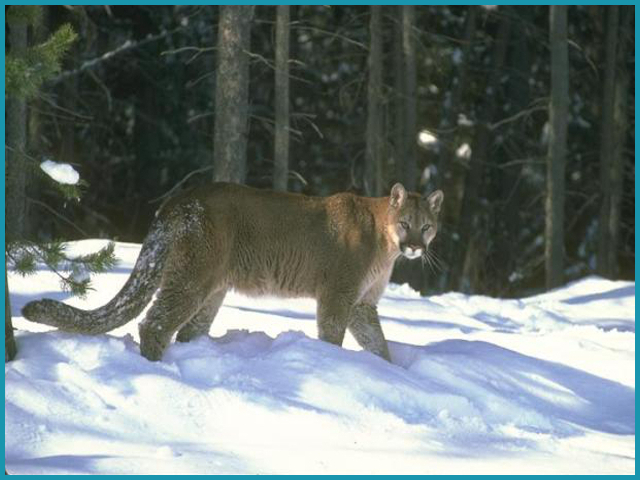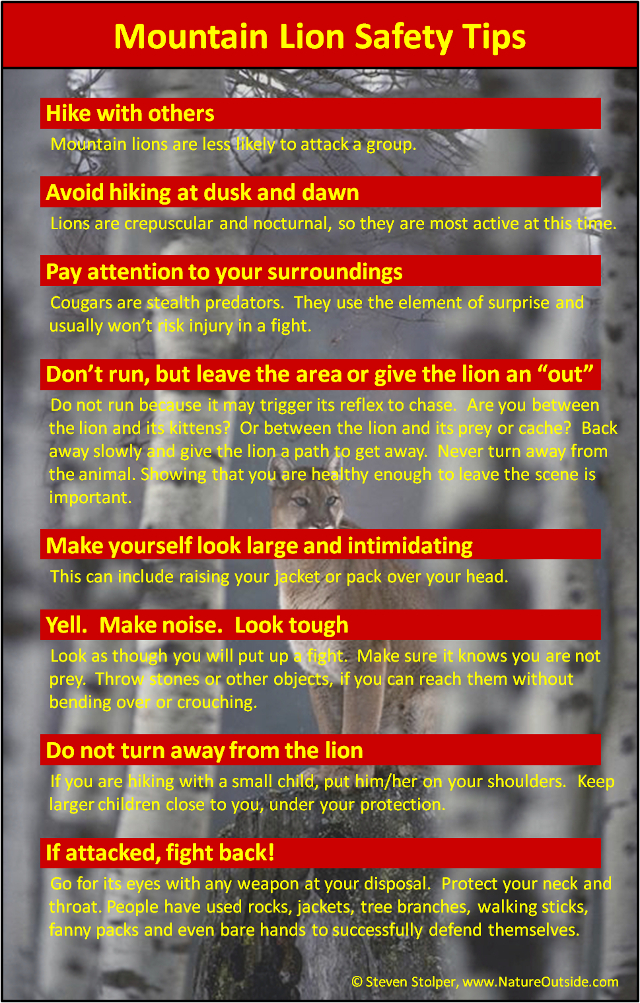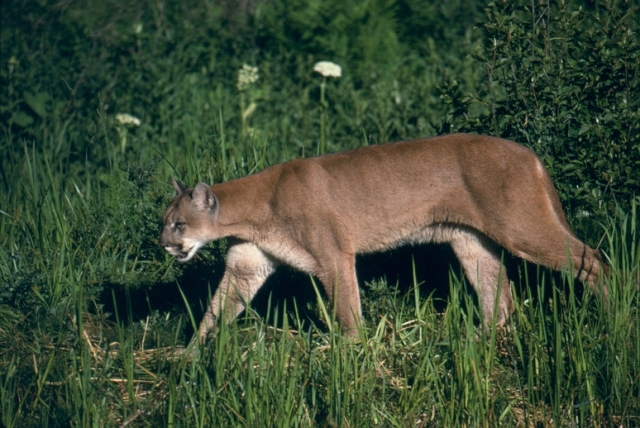
Photo by California Department of Fish & Wildlife
I don’t want to give a lion tooth decay.
You see, I’m mostly chocolate and baked goods. I consume sugary sweets and don’t eat enough vegetables. I skip meals and snack on potato chips.
No, I’m not good food for a mountain lion. High cholesterol, obesity, and possibly diabetes. That’s what awaits any big cat foolish enough to pounce on me.
You may be like me – too full of preservatives to be good mountain lion food. So I urge you, for the sake of the animals: Don’t get eaten by a mountain lion!
Reviewing Mountain Lion Safety
All kidding aside, now is a great time to review mountain lion safety. In April, a startling video of a woman’s close encounter with a mountain lion went viral. I’ll show it below. More recently, a mountain Lion attacked a five-year-old boy in Colorado. The child’s mother courageously used her bare hands to pry the toddler out of the cat’s mouth.
So let’s review some mountain lion ecology, cover mountain lion safety, and do a reality-based risk assessment.
You’re not on the Lion’s Menu
The mountain lion (Puma concolor) is also known as the cougar, puma, panther, or catamount. Modern mountain lions evolved in North America about 100,000 years ago3. Humans arrived only in the last 12,000 years. This is very important for all of us who venture into the outdoors.
Mountain lions did not co-evolve with humans in North America. So they are not programmed to hunt us. We really aren’t on the menu. This differs from Africa, where healthy lions will hunt human beings. In Africa, lions are predators and humans are prey.
In general, healthy mountain lions don’t hunt humans. Most attacks occur when old, ill, or inexperienced lions mistake humans for prey. The old or ill lions are no longer capable of successfully hunting deer, their normal food. Young lions that attack people may be struggling to hunt.
So we have some measure of security. Let’s look at an example.
The startling video below is most peoples’ nightmare. A Florida woman is trapped on a raised walkway with a cougar. She is easy prey! But the cat wants nothing to do with her. She doesn’t even put down her camera to flee! Take a look…
Warning: The woman in the video exclaims an obscenity. I would too! 🙂
In California, there have been 14 attacks in the last 28 years. Only three of them were fatal. Given the multitude of people hiking, camping, and living in mountain lion territory these numbers are quite small.
But “stuff” does happen. The last mountain lion attack in California was very close to my home. A lion attacked a six year old boy, who survived. I often hike alone on the trail where the attack occurred. And perhaps I’ve grown complacent with respect to mountain lions. But an attack like this is unusual. In fact, any mountain lion attack on a person is unusual.
Mountain Lion Safety Tips
As humans continue to encroach on wilderness areas, mountain lion encounters will become more frequent. As hikers, we need to be aware that we share our trails with big cats. If we encounter a mountain lion, we need to remain calm and act appropriately for the situation. Remember, mountain lions are ambush predators. They hunt by stalking and ambushing their prey. So if you see the mountain lion, you’ve already won half the battle.
Here are my tips for staying safe in mountain lion country:

A Realistic Risk Assessment
About 4,000 to 6,000 mountain lions live in California and attacks on humans are rare. As I mention above, there were 14 attacks in California in the last 28 years. This is small considering the number of hikers, mountain bikers, backpackers, campers, and fishermen in the outdoors every day. If mountain lions really wanted to kill people, the forest would be littered with corpses.
If you do a risk assessment, mountain lion attacks should be low on your list. Falls, hypothermia and getting lost pose much greater risks to hikers than do animal attacks. Domestic dogs and bees account for more human deaths each year.
Hike Safe, Have Fun

Photo by NPS
So do pay attention. Do take precautions. But don’t let mountain lions dampen your enthusiasm for the outdoors. In all my years of hiking, backpacking, and camping, I’ve never had the pleasure to see a mountain lion in the wild. But I’m certain that they have seen me.
And I’m still here! 🙂
References and Further Reading
Lion Sense: Traveling and Living Safely in Mountain Lion Country, Steven Torres (Affiliate Link)
Related Articles on NatureOutside
Mountain Lion Tracks – Learn to Read Them
Mountain Lion Attacks Six Year Old Boy
For fun facts and useful tips, join the free Bushcraft Newsletter.



Leave a Comment